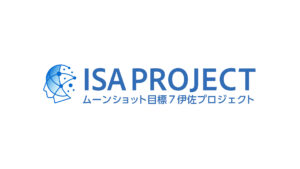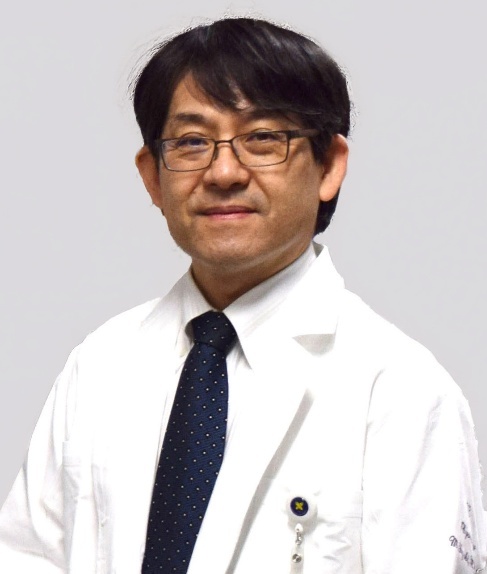Kosei Takeuchi
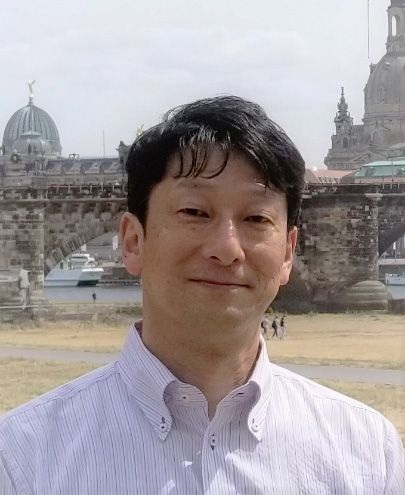
氏名Name
Kosei Takeuchi
所属・職名Affiliation, Title, etc.
International Center for Brain Science, Fujita Health University, Professor
研究室HPWebsite
一言メッセージShort Message
本プロジェクトでの研究概要Outline of the research in this project
The central nervous system (CNS), including the brain and spinal cord, relies on synapses and their microenvironment for proper function. Our research focuses on restoring damaged CNS through targeted interventions in synapse formation and extracellular matrix regulation. We have identified that modifying the extracellular matrix, which supports neuronal survival and repair, and introducing functional molecules that enhance synapse formation are highly effective approaches. Nucleic acid-based therapeutics regulate gene expression, while synthetic synaptic connectors, synthetic chimera proteins, promote synapse regeneration. This project aims to develop novel synaptic connectors and validate their effectiveness in rodent models to further enhance CNS recovery. Additionally, we are integrating AI-driven behavioral analysis with single-cell gene expression studies to establish a comprehensive evaluation system. These findings will be applied to primate models for brain repair and the treatment of Alzheimer's disease and neurodegenerative diseases.
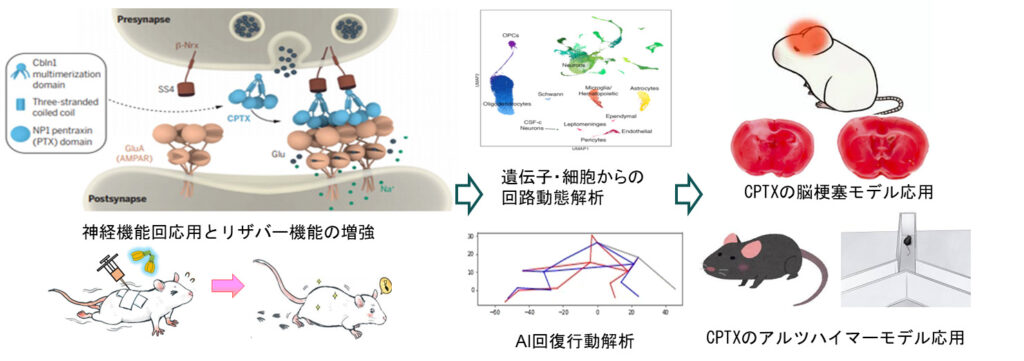
これまで主な研究内容Outline of main research so far
"Analysis of Synapse Connectors and Environmental Regulation which Involved in Neural Function Recovery, with a Focus on Spinal Cord Injury"
Building on the analysis of cell adhesion molecules involved in neural circuit formation, we have been investigating neural regeneration and methods to artificially induce it, particularly from a drug discovery perspective. In clinical practice, spinal cord injury remains a condition with no fundamental cure. To address this, we demonstrated the significance of chondroitin sulfate—an extracellular environmental factor that inhibits neural extension—and its regulation using genetically modified mice (Nature Communications, 2014). This system is now being developed into a therapeutic approach using nucleic acid-based drugs, with the goal of clinical application.
Furthermore, inspired by synapse organizers—key extracellular molecules in neuronal function—we developed synapse connectors that have enabled an unprecedented level of post-injury recovery (Science 2020). From a drug discovery standpoint, we are analyzing how the regulation of the extracellular environment and synapse connectors can comprehensively restore the latent reservoir function of neural networks.
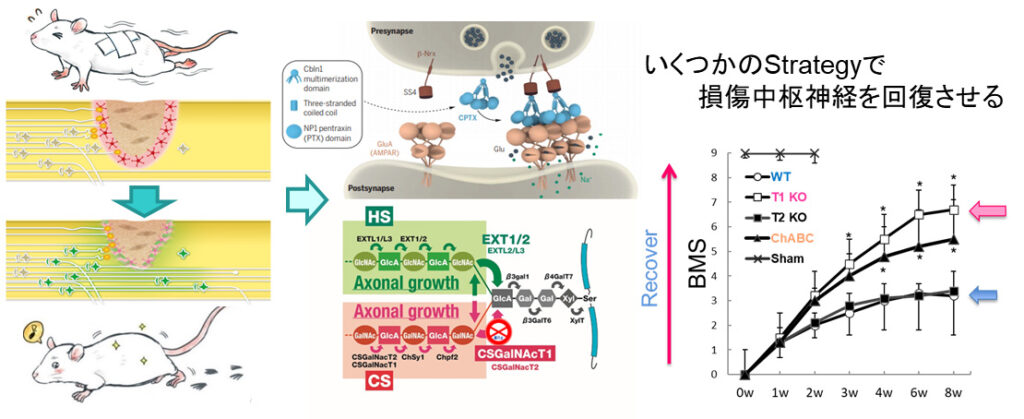
主な経歴・受賞歴等Career, Awards, etc.
- 1993:
- Graduate University for Advanced Studies (SOKENDAI), Department of Physiological Sciences (National Institute for Physiological Sciences), Ph.D.,
- 1993–1996:
- Researcher, Department of Physiological Aging, Tokyo Metropolitan Institute of Gerontology
- 1996–2000:
- Assistant Professor, Graduate School of Bioscience, Nara Institute of Science and Technology(NAIST)
- 2000–2004:
- Lecturer, Department of Supramolecular Systems, Graduate School of Science, Nagoya University
- 2004–2006:
- Group Leader, Neural Circuit Disorder Research Group, KAN Research Institute, Eisai Co., Ltd.
- 2006–2008:
- Lecturer, Department of Functional Morphology (Second Department of Anatomy), Graduate School of Medicine, Kyoto Prefectural University of Medicine
- 2008–2013:
- Associate Professor, Department of Neurobiochemistry, School of Medicine, Graduate School of Medical and Dental Sciences, Niigata University
- 2014–2025
- Professor, Department of Medical Cell Biology, School of Medicine, Aichi Medical University, (And: Director, Medical Research Creation Center)
- 2025–
- Professor, International Center for Brain Science, Fujita Health University
主要業績Major Publications
Y Shibata, Y Tanaka, S Mori, H Sasakura, Y Morioka, K Takeuchi, K Nishiwaki (2025)
Endogenous chondroitin extends lifespan by inhibiting VHA-7-mediated tubular lysosome formation
Scientific Reports 14 (1), 29651
DOI: 10.1038/s41598-024-80242-3
E Sawada, T Yamamoto, N Kishimoto, D Ohishi, H Sasakura, K Takeuchi (2025)
Creating Alternative Afferent Input to Facilitate the Regeneration of Injured Primary Afferent Neurons. Cureus 17 (2)
DOI: 10.7759/cureus.78708
N Matsushita, K Nishizawa, S Kato, Y Iguchi, R Fukabori, K Takeuchi, K Kobayashi(2023)
Catecholaminergic cell type-specific expression of Cre recombinase in knock-in transgenic rats generated by the Combi-CRISPR technology (2023)
Journal of Neuroscience Methods 381 109707-109707
DOI: 10.1016/j.jneumeth.2022.109707
Artificial excitatory synapse connector and use thereof for spinal cord injury (2023)
M Yuzaki, K Suzuki, K Takeuchi, AR Aricescu
US Patent 17/791,756
K Suzuki, J Elegheert, I Song, H Sasakura, O Senkov, K Matsuda, W Kakegawa, A J Clayton, V T Chang, M F-Ferrer, E Miura, R Kaushik, M Ikeno, Y Morioka, Y Takeuchi, T Shimada, S Otsuka, S Stoyanov, M Watanabe, K Takeuchi, R Aricescu, M Yuzaki (2020)
A synthetic synaptic organizer protein restores glutamatergic neuronal circuits.
Science (New York, N.Y.) 369(6507)
DOI: 10.1126/science.abb4853
Antisense nucleic acid for inhibiting biosynthesis of chondroitin sulfate (2020)
S Obika, Y Kasahara, K Takeuchi
US Patent 11,479,773
M Igarashi, K Takeuchi (2018)
Roles of CSGalNAcT1, a key enzyme in regulation of CS synthesis, in neuronal regeneration and plasticity
Neurochemistry International 119 77-83
DOI: 10.1016/j.neuint.2017.10.001
K Takeuchi, N Matsushita, H Kawano, M Igarashi (2017)
In vivo regulation of chondroitin sulfate gene to recover from spinal cord injury and brain infarction
DOI: 10.1186/s13041-017-0328-5
T Namba, Y Kibe, Y Funahashi, S Nakamuta, T Takano, T Ueno, S Kozawa, M Okamoto, Y Shimoda, Oda, Y Wada, T Miyata, C F Sarrailh, K Takeuchi, K Kaibuchi (2014)
Pioneering axons regulate neuronal polarization in the developing cerebral cortex.
Neuron 81(4) 814-29
DOI: 10.1016/j.neuron.2013.12.015
K Takeuchi, N Yoshioka, S Onaga, Y Watanabe, Shinji Miyata, Toshiya Sato, Minesuke Yokoyama, N Matsushita, M Nakamura, H Okano, K Sakimura, H Kawano, H Kitagawa, M Igarashi (2014)
Chondroitin sulphate N-acetylgalactosaminyl-transferase-1 inhibits recovery from neural injury. Nature communications 4 2740-2740
DOI: 10.1038/ncomms3740

